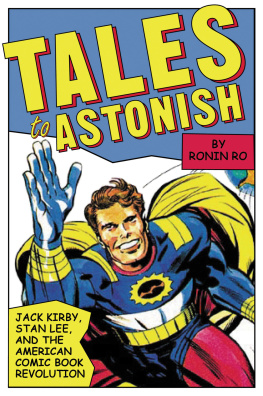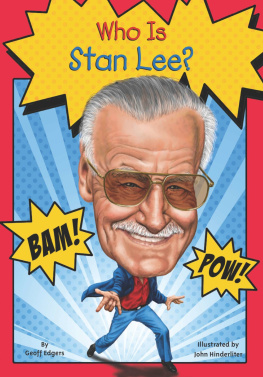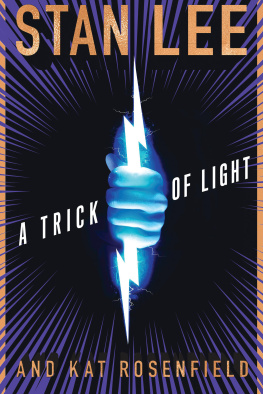STAN LEE

Stan Lee, 1996. Evan Hurd Photography, Corbis Historical Collection, Getty Images.
Stan Lee
A Life in Comics

LIEL LEIBOVITZ

Copyright 2020 by Liel Leibovitz. All rights reserved. This book may not be reproduced, in whole or in part, including illustrations, in any form (beyond that copying permitted by Sections 107 and 108 of the U.S. Copyright Law and except by reviewers for the public press), without written permission from the publishers.
Yale University Press books may be purchased in quantity for educational, business, or promotional use. For information, please e-mail (U.K. office).
Set in Janson type by Integrated Publishing Solutions, Grand Rapids, Michigan.
Printed in the United States of America.
Library of Congress Control Number: 2019950942
ISBN 978-0-300-23034-5 (hardcover : alk. paper)
A catalogue record for this book is available from the British Library.
This paper meets the requirements of ANSI/NISO Z39.48-1992
(Permanence of Paper).
10 9 8 7 6 5 4 3 2 1
To Lisa, Lily, and Hudson, my heroes
CONTENTS
1

So Whats the Risk?
S TAN L EE was ready to quit.
It was the summer of 1961, and the past seven years had been packed with enough drama to fill several of the schlocky comic books he and his colleagues were churning out each week. The troubles began in 1954, when Fredric Wertham, a Bavarian-born psychiatrist and a disciple of Freuds, embarked on an anticomics crusade: he had interviewed scores of juvenile delinquents, he announced in his bookthe unimprovably titled Seduction of the Innocentand was shocked to learn they were all avid comics readers. Having little patience for the distinction between correlation and causation, Congress took up Werthams cause, andin a series of televised hearings that began the same month as the Army-McCarthy hearings and evoked the same feverish strand of Cold War paranoiasummoned a roster of comic book publishers to chastise them for featuring excessively violent images. Eager to keep on the right side of regulation, the publishers rushed to create the Comics Code Authority, which set strict guidelines of self-censorship. In every instance, the 1954 code decreed, good shall triumph over evil and the criminal punished for his misdeeds. Nor could seduction be portrayed, to say nothing of sex perversion or any inference to same.
The industrys self-imposed piety, however, did little to win it new fans. Years later, Lee recalled striking up a conversation with a gun salesman while spending a weekend in the Catskills and mentioning that he was a comic book editor. That is absolutely criminal, the man scoffed. Totally reprehensible. You should go to jail for the crime youre committing.
Booted from his spacious office, Lee now sat at a small cubicle in the companys profitable mens magazine division, spending his days working on anodyne stuff like the foibles of two models named Millie and Chili or the adventures of a diaper-wearing dragon. Hed been with the company, which started as Timely Comics and was now called Atlas, since 1939, and had risen rapidly through its ranksfrom inkwell filler and sandwich fetcher to editor in chiefbut now he was beginning to think the business was moribund. Its like a ship sinking, he
But getting off meant risking unemployment, and that Lee just couldnt do. Growing up, hed come home from school each day and watch his father, a fabric cutter in the Garment District robbed of his livelihood by the Great Depression, sit at the kitchen table and stare blankly into space. With a wife and a small child to care for, Lee could think of no fate more terrifying than replaying the central drama of his childhood, which centered on his parents bickering about money. Unhappy, he tried to dream up other ways of making a living, such as self-publishing a book of photographs with humorous captions or trying to sell a TV script. There was one brief glimmer of hope in 1958, when he and a friend, the artist Joe Maneely, sold an independent newspaper comic strip called Mrs. Lyons Cubs, about a Scouting den mother and her gaggle of wisecracking boys, but it, too, was doomed: having lost his glasses, and having had a little bit to drink, Maneely stepped out between two train cars to get some fresh air on his commute back home to New Jersey one evening and fell to his death.
Lee soldiered on for a few more years, but each day his view of the industry grew dimmer. He was never a comic book fanaticas a child, he read Dickens and Twain, not Superman and Batmanand he was beginning to wonder whether the genre hed spent twenty years writing and editing was just a passing fad. And even if it wasnt, did he really want to spend the rest of his life coming up with story lines about creatures named Groot, Droom, or Krang? Nearing forty, Lee wanted to write something that mattered, real stories about complicated people who struggled with a range of emotions you couldnt show when all you did was comics. Getting his start in the business, he took on the moniker Stan Lee, keeping his real nameStanley Martin Lieberfor that great American novel hed always intended to write. Maybe, he thought, maybe it was time to get serious.
The thought recurred with particular urgency one day when his boss, Martin Goodman, came back from a round of golf and summoned Lee to his office. Hed just played with the publisher of DC Comics, Jack Liebowitz, he told Lee, and he learned that DC was making a mint from a new series called the Justice League. The idea was simple: rather than showcase just one superhero, DC decided to throw all its eggs in one basket, drafting Superman, Batman, Wonder Woman, the Flash, and others into one megatitle. It was selling like hotcakes, Liebowitz told Goodman, who rushed back to work and ordered his editor to come up with a knockoff that could also do some brisk business.
It was the last thing Lee wanted to hear. When he got back home that evening, he told his wife, Joanie, about his conversation with Goodman. She asked him what he said, and Lee sighed. I said Id think about it, he replied, but really, whats the point? I dont want to just keep recycling old characters. Then, after a pause, he admitted out loud what had, until then, been nothing more than a dark thought: I feel like quitting.
Joanie was silent for a moment. Look, Stan, she finally said, if you want to quit, you know Ill support you. But think about this: If Martin wants you to create a new group of superheroes, this could be the chance for you to do it the way youve always wanted to. You could dream up plots that have more depth and substance to them, and create characters that have interesting personalities, who speak like real people. It could be fun, she said, to experiment a bit; besides, she added with a smile, the worst that can happen is that Martin gets mad and fires you. But you want to quit anyway, so whats the risk?
Convinced, Lee got to work. He had no concrete ideas. What he did have was a list of resentments, compiled over two decades of watching the industry produce titles he considered derivative or worse.
Next page











